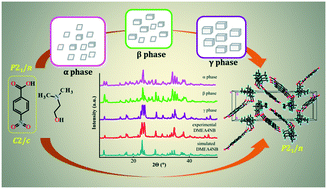The role of 4-nitrobenzoic acid polymorphs in the crystallization process of organic acid–base multicomponent systems†
Abstract
The role of polymorphs in understanding and controlling the crystallization process from solution of an organic acid–base system is reported. Herein, the crystallization process of dimethylethanolammonium 4-nitrobenzoate (DMEA4NB) is explored through different pathways of crystallization, using 4-nitrobenzoic acid polymorphs crystallized in different space groups: monoclinic P21/n (4NBH) and C2/c (4NBH*), respectively. The crystal growth process was investigated by complementary experimental techniques such as single crystal and powder X-ray diffraction, Fourier transform infrared spectroscopy, hot-stage optical microscopy and thermogravimetric analysis correlated with an ab initio computational study. The experimental and theoretical data revealed that 4NBH is more stable than 4NBH*, indicating that 4NBH* is more favorable for a one-step crystal growth process, while the 4NBH polymorph leads to DMEA4NB formation through three intermediate phases. The changes over time associated with solid–solid phase transformations in the crystal growth process are evaluated. The opacification process of DMEA4NB has indicated the partially reversible transformation of the product into an intermediate phase.



 Please wait while we load your content...
Please wait while we load your content...